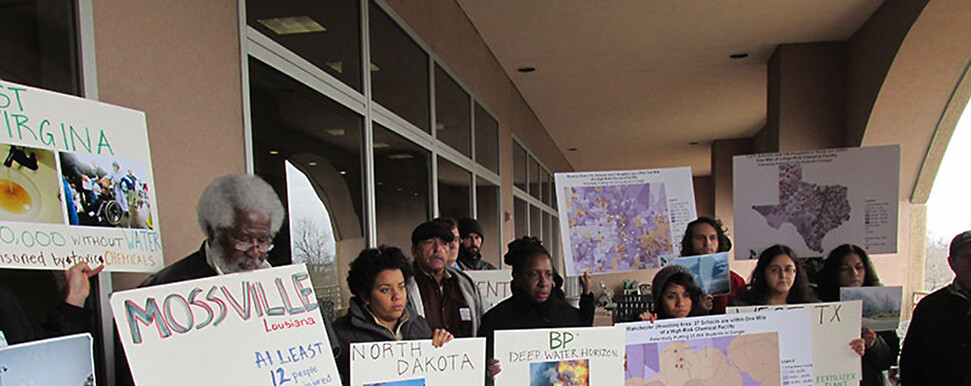
Media
January 26, 2022More than 70 State Legislators Call on EPA to Prevent Chemical Disasters, Protect Workers and Prioritize Environmental Justice
Letter to EPA Administrator Regan Urges Meaningful Reform of Rule that Manages Over 12,000 Chemical Facilities Nationwide
FOR IMMEDIATE RELEASE
by Coming Clean & the Environmental Justice Health Alliance for Chemical Policy Reform
Press contact: Shayna Samuels, 718-541-4785, shayna@ripplestrategies.com
#preventchemicaldisasters #FixtheRMP
A letter was sent today by over 70 elected officials from 16 states and territories to EPA Administrator Michael Regan urging meaningful reform of the federal policy that is intended to prevent chemical disasters. Unfortunately, explosions and toxic leaks occur regularly at high-risk chemical facilities, which disproportionately affect workers, communities of color and low-income communities nationwide, making this a key environmental justice issue.
“We and our constituents are unwilling to continue living with the constant threat of chemical disasters that could destroy our neighborhoods, businesses, and communities, when safer chemicals and technologies exist,” reads the letter. “ Injuries, death and disease are not acceptable risks, and our communities are not sacrifice zones.”
The letter centers around the EPA’s Risk Management Plan, or RMP, Rule which regulates over 12,000 high-risk chemical facilities nationwide and is currently being updated. Signatories include legislators from: Colorado, Delaware, Guam, Hawaii, Kentucky, Maine, Massachusetts, Montana, New Hampshire, New York, Ohio, Oregon, Pennsylvania, Utah, Washington DC, and West Virginia. The full letter and list of signatories can be seen here.
“Chemical releases, fires, and explosions occur across the United States almost constantly,” says the letter. “In just ten years, there were over 1,500 reported chemical releases or explosions at RMP facilities nationwide. These caused over $2 billion in property damages; evacuation or “shelter in place” of half a million people; over 17,000 reported injuries; and 59 reported deaths. With lax reporting requirements and no systematic health surveillance in place, these numbers likely underestimate the problem. People who live in the potential disaster zones around many facilities are disproportionately people of color and low income, and many communities host multiple - sometimes dozens - of hazardous facilities, contributing to cumulative impacts.”
The letter specifically calls for the following measures to be included in the updated RMP:
- Prevent disasters by requiring hazard reduction. Many of the chemical facility incidents from the past could have been prevented if safer chemicals or processes were used in the first place. Root cause analyses of significant incidents, independent third-party safety audits, and other best practice prevention measures should also be mandatory.
- Better prepare chemical facilities for climate impacts. This can be done by: expanding RMP coverage to more facilities in areas prone to natural disasters; building prompt implementation and compliance deadlines into new rules; requiring safer shutdown and startup procedures; collecting and publicly sharing air emissions data in real time; and requiring that communities receive timely information about natural disaster response plans in ways that are clearly communicated to those at risk.
- Include common-sense emergency response and incident management measures. Back-up power, alerts in multiple languages (including advance community notification), real-time fenceline air monitoring, leak detection and repair, emergency response exercises, and similar best practices should not be optional.
- Increase enforceability, corrective action, and accountability. There must be sufficient terms to assure RMP compliance, and require meaningful worker involvement, participation, and stop work authority (including an anonymous safety and near-miss hotline). Clear, expeditious compliance deadlines are essential.
- Expand coverage of the RMP program. The current scope of the RMP program is inadequate. More facilities, processes and chemicals (including ammonium nitrate and other reactives) must be covered. One process or part of a facility should trigger coverage for the whole facility.
- Account for cumulative hazards from multiple facilities and underlying vulnerabilities. RMP facilities are frequently located in close proximity to each other, as well as additional facilities that continuously release multiple pollutants. Oftentimes, communities neighboring these facilities - disproportionately made up of people of color and low income people - are faced with a host of other social and environmental conditions that increase their susceptibility to health threats. EPA must recognize that more layers of prevention are needed to protect communities where these cumulative hazards exist.
“Our states, cities, and constituents cannot wait any longer for companies to voluntarily decide to remove these hazards at their convenience,” says the letter. “Chemical incidents can be prevented by incorporating common-sense policies into a strengthened RMP. Many safer chemicals and processes already exist, and more can be developed. What is missing, but urgently needed, are national requirements for transition to safer alternatives whenever possible, and other proven measures that can help prevent disasters.”
###
Coming Clean is a collaborative network of frontline community activists, environmental justice organizations, and policy, science and market experts, committed to transforming the chemical industry so that it is no longer a source of harm. For twenty years, we have fought to end legacy pollution in communities of color, ban toxic pesticides that harm farmworkers and their families, regulate hazardous facilities, and end the sale of unsafe products in dollar stores and other retailers across the country.
The Environmental Justice Health Alliance for Chemical Policy Reform is a national network of grassroots Environmental and Economic Justice organizations and advocates in communities that are disproportionately impacted by toxic chemicals from legacy contamination, ongoing exposure to polluting facilities and health-harming chemicals in household products. EJHA supports a just transition towards safer chemicals and a pollution-free economy that leaves no community or worker behind.
